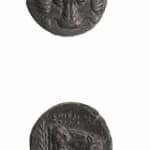Ionian Silver Tetradrachm of Samos, 380 BCE - 365 CE
Silver
C.2049
Obverse: A Lion-Skin Mas Reverse: The Forepart of a Bull Facing Righ The island of Samos sits in the Eastern Aegean Sea, not far from the coasts of Asia Minor...
Obverse: A Lion-Skin Mas
Reverse: The Forepart of a Bull Facing Righ
The island of Samos sits in the Eastern Aegean Sea, not far from the coasts of Asia Minor (modern Turkey), where the ancient Greek culture of Ionia flourished. The development of the island was aided by its strategic location at the maritime crossroads that linked mainland Greece to the wealthy merchants of the East. The name, Samos, probably derives from the Phoenician words meaning, “a place somewhere high.” Historically, the island has been known by several other names including Parthenia, Imvrasia, Anthemis, Dryousa, Doryssa, and Phyllas. The earliest settlers belonged to the Pelasgic tribes that spread the worship of the goddess Hera. Hera was believed to be the protector of the island where, according to mythology, she was born on the banks of the river Imbrasus under a very old willow tree.
How many hands have touched a coin in your pocket or purse? What eras and lands have the coin traversed on its journey into our possession? As we reach into our pockets to pull out some change, we rarely hesitate to think of who might have touched the coin before us, or where the coin will venture to after it leaves our hands. More than money, coins are a symbol of the state that struck them, of a specific time and location, whether contemporary currencies or artifacts of a long forgotten empire. This stunning hand-struck coin reveals an expertise of craftsmanship and intricate sculptural detail that is often lacking in contemporary machine-made currencies. This ancient coin is a memorial to the glory both of the island of Samos and the greater Ionian region passed from the hands of civilization to civilization, from generation to generation that still appears as vibrant today as the day they were struck.
Reverse: The Forepart of a Bull Facing Righ
The island of Samos sits in the Eastern Aegean Sea, not far from the coasts of Asia Minor (modern Turkey), where the ancient Greek culture of Ionia flourished. The development of the island was aided by its strategic location at the maritime crossroads that linked mainland Greece to the wealthy merchants of the East. The name, Samos, probably derives from the Phoenician words meaning, “a place somewhere high.” Historically, the island has been known by several other names including Parthenia, Imvrasia, Anthemis, Dryousa, Doryssa, and Phyllas. The earliest settlers belonged to the Pelasgic tribes that spread the worship of the goddess Hera. Hera was believed to be the protector of the island where, according to mythology, she was born on the banks of the river Imbrasus under a very old willow tree.
How many hands have touched a coin in your pocket or purse? What eras and lands have the coin traversed on its journey into our possession? As we reach into our pockets to pull out some change, we rarely hesitate to think of who might have touched the coin before us, or where the coin will venture to after it leaves our hands. More than money, coins are a symbol of the state that struck them, of a specific time and location, whether contemporary currencies or artifacts of a long forgotten empire. This stunning hand-struck coin reveals an expertise of craftsmanship and intricate sculptural detail that is often lacking in contemporary machine-made currencies. This ancient coin is a memorial to the glory both of the island of Samos and the greater Ionian region passed from the hands of civilization to civilization, from generation to generation that still appears as vibrant today as the day they were struck.



